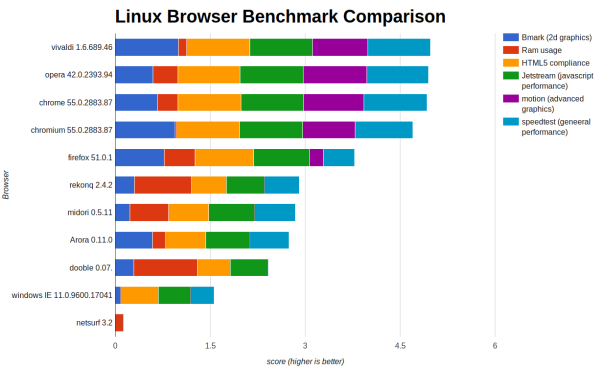Presented below are the combined benchmarks of the 10 most popular browsers on Linux. These are (as tested) Arora 0.11.0, Vivaldi 1.6.689.46, Chrome 55.0.2883.87, Chromium 55.0.2883.8, Dooble 0.07, Firefox 51.0.1, Midori 0.5.11, Netsurf 3.2, Opera 42.0.2393.94, Rekonq 2.4.2 and finally for comparison I tested Internet Explorer 11.0.9600.17041 on Windows.
I ran 6 main benchmarks most of which consisted of multiple parts. The benchmarks were:
- BMark a benchmark testing the graphics capabilities of the browser.
- HTML5 compliance test. a test that measures out of 555 how many HTML5 features the browser supports.
- Jetstream a comprehensive JavaScript benchmark consisting of multiple tests.
- MotionMark another graphics test, testing more advanced features.
- Speedometer a general HTML/JavaScript benchmark.
- RAM test. I created a 15MB HTML file consisting of graphics, text and JavaScript. I then loaded it into 10 tabs (all browsers supported multiple tabs) and measured how much RAM was being used by each browser process.
The testing methodology was to close all other applications, open browser, load the page, let it settle, then run the nechmark. The test rig* was the same for each browser.
The results for each browser is presented in the table below. A 0 indicated that the browser was unable to run that benchmark. Higher scores are better.
| Browser |
Bmark |
RAM |
HTML5 standard |
Jetstream |
motion |
speedtest |
| vivaldi 1.6.689.46 |
1670 |
826.2 |
505 |
110.3 |
173.83 |
73.01 |
| chromium 55.0.2883.87 |
1571 |
899.1 |
505 |
111.69 |
163.77 |
67.81 |
| firefox 51.0.1 |
1287 |
584.9 |
471 |
98.596 |
42.65 |
36.6 |
| chrome 55.0.2883.87 |
1105 |
693.7 |
507 |
110.53 |
188.45 |
74.2 |
| opera 42.0.2393.94 |
993 |
647.9 |
500 |
111.19 |
198.37 |
72.75 |
| Arora 0.11.0 |
985 |
776.2 |
322 |
77.84 |
0 |
45.68 |
| rekonq 2.4.2 |
500 |
299.8 |
279 |
67.129 |
0 |
41.1 |
| dooble 0.07. |
496 |
235.8 |
263 |
66.775 |
0 |
0 |
| midori 0.5.11 |
384 |
498.3 |
319 |
81.298 |
0 |
47.51 |
| windows IE 11.0.9600.17041 |
139 |
916.184 |
302 |
57.449 |
0 |
27.1 |
| netsurf 3.2 |
0 |
832.2 |
0 |
0 |
0 |
0 |
I took the table and normalized the results so they were all on a scale of 0 to 1, I then added each browsers individual scores together to create the final graph.

The browsers seem to be split into two main groups. The big web kit based browsers , Firefox and the smaller lesser well known browsers. Most browsers could run all the tests, however, the smaller ones could not always manage MotionMark. Netsurf as an outlier could only manage to run one test, which was RAM.
Conclusion
The browser that performed best overall was Vivaldi, just edging out Opera and Chrome. Firefox came halfway between the heavyweight browsers and the smaller browser projects. Note that the most memory efficient browser was Dooble, which used around a quarter of the RAM (235MB) as the chromium (899MB). For interest I also bench marked Internet Explorer 11 on the same system running windows server 2008. Apart from Netsurf (which hasn’t been updated since 2009) it came last.
I think the most interesting take away is that the main webkit browsers are useful if you have a powerful machine with plenty of resources since they can run all tests, are highly HTML5 compliant and fast. If however you are short of RAM then perhaps Dooble or ReKonq would be a better fit.
Cleerline
—————-
- Test rig
- System: Host: cleerline-mint Kernel: 4.4.0-53-generic x86_64 (64 bit)
- Desktop: Cinnamon 3.2.7 Distro: Linux Mint 18.1 Serena
- Machine: Mobo: ASRock model: 970 Pro3 R2.0
- Bios: American Megatrends v: P1.50 date: 10/02/2013
- CPU: Quad core AMD Phenom II X4 965 (-MCP-) cache: 2048 KB
- clock speeds: max: 3400 MHz 1: 800 MHz 2: 2200 MHz 3: 2200 MHz
- 4: 800 MHz
- Graphics: Card: NVIDIA GT200 [GeForce GTX 260]
- Display Server: X.Org 1.18.4 drivers: nouveau (unloaded: fbdev,vesa)
- Resolution: 1920×1200@59.94hz
- RAM: 8GB
